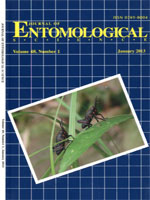The objective of this 3-yr study was to determine species composition and abundance of stink bugs (Heteroptera: Pentatomidae) and their natural enemies in alfalfa, Medicago sativa L., in Georgia. Six species of phytophagous stink bugs, Nezara viridula (L.), Euschistus servus (Say), Thyanta custator custator (F.), Euschistus quadrator Rolston, Oebalus pugnax pugnax (F.), and Chinavia hilaris (Say), and one predatory species, Podisus maculiventris (Say), occurred in alfalfa. Generally, density of N. viridula, the predominant stink bug species, was high in seeding alfalfa in the late spring-early summer, and parasitization of this stink bug by Trichopoda pennipes (F.) could reach high levels as density of the pest increased in the crop. Euschistus servus and T. c. custator together comprised the second most predominant group of stink bugs in this crop. Based on seasonal occurrence of nymphs (all 5 instars) and adults, nymphal development time, ovarian development time, and reproductive status of adults (N. viridula only), alfalfa is a reproductive host for N. viridula and E. servus, and perhaps for T. c. custator. Mainly adults of E. quadrator, O. p. pugnax, and C. hilaris were present in the crop. Stink bug predators included Geocoris spp., Orius insidiosus (Say), spiders, lady beetles, nabids, reduviids, and Solenopsis invicta Buren.
BioOne.org will be down briefly for maintenance on 17 December 2024 between 18:00-22:00 Pacific Time US. We apologize for any inconvenience.
How to translate text using browser tools
1 January 2013
Stink Bugs (Heteroptera: Pentatomidae) and their Natural Enemies in Alfalfa in South Georgia
P. Glynn Tillman
ACCESS THE FULL ARTICLE
Euschistus servus
Medicago sativa
Nezara viridula
Trichopoda pennipes





